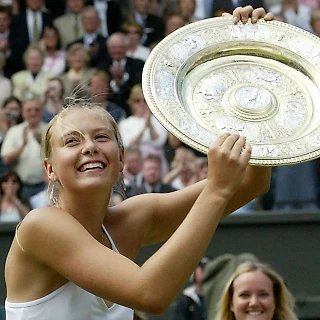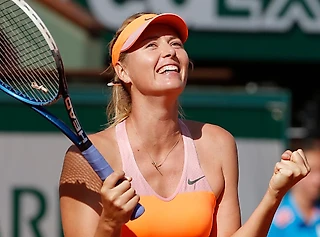Five thoughts
Mark Hodgkinson in Paris
Friday, 8 June 2012
Five thoughts as Maria Sharapova prepares for a possible career grand slam.
Put your fingers in your ears and you can still hear them talking about Sharapova’s grunting. There’s a big, screaming myth about Maria Deci-Belle. You will often be told that Sharapova doesn’t wail on the practice court, that she puts herself on mute during training. Then you will hear, ‘if she doesn’t do it in practice, why the need for all the grunting when she’s playing a match?’ The 200-odd spectators who wandered into Court Six on a Friday lunchtime – perhaps attracted by the noise? – heard for themselves that the new world number one also grunts in practice.
And since a good half of those fans were filming her with their cameras, there is plenty of video evidence; word should get around. The Parisians will undoubtedly boo Sharapova if they feel as though she is getting too loud in Saturday’s final with Sara Errani, but they should not imagine that the Siberian finds it easy to turn her grunting on and off, and they should certainly not believe that she is trying to unsettle her opponent. Grunting is just one of those things that Sharapova does, like staring at the backdrop between points. She’s not a doll with an on-off switch, to be seen and not heard.
The Parisians should save any anti-American feeling for the battles that really matter – like Big Macs at the Louvre. How will Paris greet a career slam for the US-based Sharapova? The Americanisation of European culture tends to upset a lot of people in Paris. Sharapova is a citizen of the world – Siberia, Florida, California, wherever – who speaks English in an MTV accent. Some at Roland Garros consider Sharapova to be too Americanised for their tastes (she once became so fed up with the booing here that she was picked up saying, “Allez up your f—— ass”). The reality is that Sharapova’s transatlantic background, and therefore transatlantic appeal, are good for the sport.
A victory for Errani would be the romantic ending to this women’s tournament. A victory for Sharapova would be the best thing that could happen to the women’s game as the tour looks for new sponsors. Errani could cost the tour millions of dollars.
Maria is the Stakhavonite of the women’s tour – no one has a stronger work ethic. Players prepare in different ways. Sharapova trains with her gameface on (just like she trains with her game-vocals). There was no snorting with laughter or looning around on Court Six. Sharapova has said herself that she has made enough money to feed her great-grandchildren. If Maria was plain, she would not be so wealthy, but there would be a much greater and wider appreciation for how much she has put into her tennis career. She has always been more of a striver than a diva; there is no sense of entitlement. There was a time when it looked as though her shoulder problems – which required fixing with a surgeon’s blade – could end her tennis life.
At that point, many other players would have been satisfied with their lot, with having won Wimbledon at 17, then then the US Open two years later, and after another two-year gap, the Australian Open. But Sharapova, 25, felt as though there was much more she could achieve with a tennis racket. By reaching a first French Open final, Sharapova will become the world No 1 again on Monday. For the first time in four years, the computer will recognise her as the alpha female. If she wins La Coupe Suzanne Lenglen, it would bring her a first grand slam title since the 2008 Australian Open. It would also signify that the comeback was complete.
If Court Philippe Chatrier is not full when the final starts, don’t think that Paris has forgotten about the women. There were also huge areas of empty green seats when Rafael Nadal’s semi-final against David Ferrer started on Friday. Lunch always trumps tennis at Roland Garros. You clear your plate first and then you fill the stadium.










Мартина Навратилова считает, что у россиянки Марии Шараповой больше шансов выиграть «Ролан Гаррос»-2012, чем у ее соперницы итальянки Сары Эррани.
Решающий матч Открытого чемпионата Франции в женском одиночном разряде пройдет в Париже в субботу.
«Дорога для Марии открыта, - сказала Навратилова на пресс-конференции. - Она играет в изумительный теннис. Лишь в матче против (Клары) Закопаловой она испытала проблемы, а так в 80 процентах проведенных здесь игр она одерживала победы за явным преимуществом, доминируя на подаче соперниц. Думаю, что это станет ключевым моментом в финале».
По словам Навратиловой, Эррани «играет в смелый теннис». «Но я не знаю, насколько этого будет достаточно при игре Марии на приеме», - добавила она.
Самая титулованная теннисистка в истории заметила, что в финале будет настоящая игра нервов. «Эррани нечего тут терять, она уже все заработала и доказала. Мария также здесь уже много получила, но ей есть, что терять. Поэтому этот матч будет интересен с точки зрения психологии соперниц, но сейчас Мария - чемпионка на бумаге, это без сомнений», - заявила она.
Шарапова и Эррани никогда раньше не играли между собой, и этот факт, по мнению Навратиловой, придаст дополнительную интригу матчу.
«Первая встреча, и в финале турнира Большого Шлема. Это невероятно. Два человека никогда раньше не играли друг с другом, хотя в одно время занимались в теннисной академии Ника Боллетьери», - сказала она.
Россиянка Мария Шарапова сумеет победить итальянку Сару Эррани в финале Открытого чемпионата Франции по теннису, если будет удачно действовать в привычной ей атакующей манере, считает известный в прошлом российский теннисист, двукратный чемпион Кубка Кремля Андрей Черкасов.
Шарапова и Эррани в субботу разыграют чемпионский титул «Ролан Гаррос», второго в сезоне турнира Большого Шлема. В полуфиналах россиянка взяла верх над Петрой Квитовой из Чехии, а итальянка - над Самантой Стосур из Австралии.
«В финале в первую очередь все будет зависеть от успешности агрессивных действий Марии, от ее атакующей игры, - отметил Черкасов в телефонном разговоре. - Я считал, что если она пройдет Квитову, то у нее очень хорошие шансы выиграть турнир. Неважно, с кем бы Шарапова играла - со Стосур или с Эррани. Итальянка проводит свой лучший сезон в карьере, но в финале все будет зависеть от Марии. В полуфинале Шарапова действовала очень неординарно - использовала и укороченные удары, и «свечки». Это меня очень порадовало».
Стабильность - главный козырь Эррани
По словам эксперта, главный фактор, благодаря которому Эррани удалось дойти до финала - стабильность ее действий.
«Стосур - теннисистка непредсказуемая, в полуфинале она то подавала по три подачи навылет в гейме, то делала нелепые, необъяснимые ошибки. А итальянке стабильность помогла выиграть, - подчеркнул Черкасов. - Эррани находится в оптимальной физической кондиции, передвигается намного лучше по корту, чем ее предыдущие соперницы - Иванович, Кузнецова, Стосур. У нее очень хороший удар справа, она очень цепкая теннисистка, и я думаю, что она до финала дошла заслуженно».
Одним из важных компонентов успеха Шараповой в финальном матче «Ролан Гаррос» будет прием подачи итальянки, считает собеседник агентства.
«Эррани подает «процентно», и Стосур в полуфинале старалась сразу же «забивать» мячи с приема. Думаю, если Марии удастся делать то же самое и заставлять итальянку подавать мощнее, акцентированно, то ей будет легче, - пояснил Черкасов. - Ну а у самой Шараповой с подачей вроде бы все в порядке. Важно играть в несколько ударов, подавить соперницу мощью. Эррани будет стараться играть как можно цепче, возвращать все мячи на ту сторону, «разводить» Шарапову по корту. Но я не думаю, что Мария будет отдавать инициативу».
В преддверии финала «Ролан Гаррос» Мария Шарапова ответила на вопросы российских журналистов.
http://video.eurosport.ru/tennis/french-op...vid235129.shtml
3:00 PM Start
Women’s Singles - Finals
Sara Errani(ITA)[21] vs. Maria Sharapova(RUS)[2]
Men’s Doubles - Finals
Max Mirnyi(BLR)[1] /
Daniel Nestor(CAN)[1] vs. Bob Bryan(USA)[2] /
Mike Bryan(USA)[2]